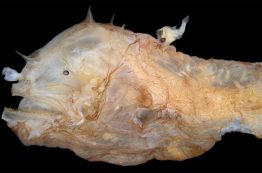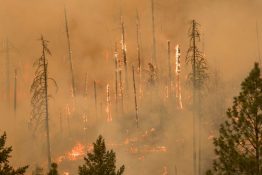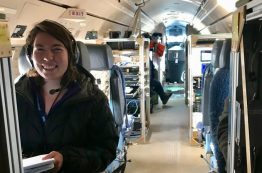Deep-sea anglerfishes employ an incredible reproductive strategy. Tiny dwarfed males become permanently attached to relatively gigantic females, fuse their tissues and then establish a common blood circulation. In this way, the male becomes entirely dependent on the female for nutrient supply, like a developing fetus in the womb of a mother or a donated organ in a transplant patient. In anglerfishes, this unusual phenomenon is called “sexual parasitism” and contributes to the reproductive success of these animals living in the vast space of the deep sea, where females and males otherwise rarely meet.
Read more at UW News »Expert FAQ: Wildfires in the Pacific Northwest during the COVID-19 pandemic
Forest fires are one of nature’s oldest land management tools. For more than 10,000 years, Indigenous people in the Pacific Northwest have harnessed the power of fire to control the threat of destructive wildfires and encourage new growth across landscapes. In recent centuries, as the number of people living in forested areas has increased and large amounts of fuel have built up over years of suppression, large seasonal wildfires are becoming more common.
Read more at UW News »UW Environment announces 2020-2021 dean’s office scholarship recipients
The College of the Environment is pleased to announce the following undergraduate and graduate scholarships awarded for 2020-21: Del Rio Endowed Environmental Studies Scholarship The Del Rio Family Foundation established the Del Rio Endowed Scholarship Fund for Environmental Studies to encourage and support students with an interest in the environment who are participating in the Educational Opportunity Program. The Program promotes academic success and graduation for under-represented ethnic minority, economically disadvantaged and first-generation college students at the University of Washington.
Read more »Pristine air over Southern Ocean suggests early industrial era’s clouds not so different from today’s
A new study uses satellite data over the Southern Hemisphere to understand the makeup of global clouds since the Industrial Revolution. This research tackles one of the largest uncertainties in today’s climate models — the long-term effect of tiny atmospheric particles on climate change. Research led by the University of Washington and the University of Leeds in the United Kingdom uses remote, pristine parts of the Southern Hemisphere as a window into the early-industrial atmosphere.
Read more at UW News »Conservation planning for a wild and thriving Cascadia
With ever-shrinking pristine habitats across the region and globe, wildlife is often hard-pressed to find a place to call home. Even if they find a suitable home today, the question remains if it will still be suitable tomorrow. With climate change already underway and increasing human presence in wild landscapes, land managers and conservation organizations continually wrestle with this issue here in the Pacific Northwest and across the world.
Read more »





